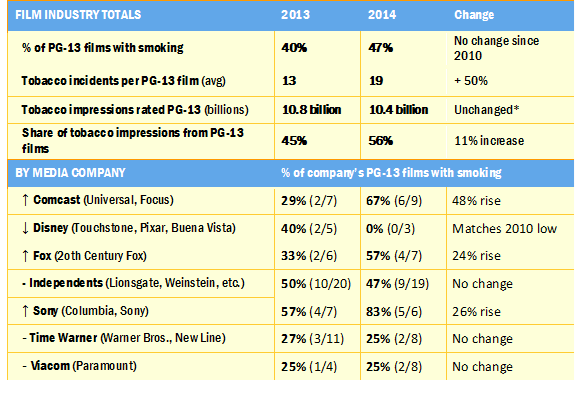February 19, 2015
Stanton A. Glantz, PhD
Smoking in US top-grossing PG-13 movies, 2013-2014: Still high
Three metrics are used to track smoking in movies overall, by rating and by company:
• percentage of films with smoking;
• tobacco incidents per movie (average for all movies and for movies with smoking);
• in-theater tobacco impressions (an index of total exposure from all movie platforms).

Observations for 2013 and 2014 data
• The share of PG-13 movies with smoking (47%) has not changed substantially since 2010, hovering between 40-50%. However, the share of R-rated films with smoking (61%) was the lowest observed since at least 2002.
• The average number of tobacco incidents in 2014 PG-13 films, smoking and smokefree, tied for the highest level in a decade (19 incidents per film). The 2014 PG-13 movies with smoking averaged more smoking incidents (42) than since at least 2002.
• Youth-rated (G/PG/PG-13) movies delivered 57% of all in-theater tobacco impressions in 2014, about average since 2002 but well above the historic low, in 2010 (35%).
• In 2014, one out of six MPAA-member “major studios” improved their track record, three performed worse than the year before, and two were unchanged. Different companies have improved or gotten worse in each the of the past five years, despite the fact that all MPAA-member companies have policies supposedly designed to discourage tobacco depictions in their youth-rated movies. As health authorities including the US CDC have observed, individual studio polices cannot be relied upon to keep smoking out of the movies that kids see most.
• Worth noticing is that 42% (10/24) of top-grossing PG-13 movies with smoking were released by “independent” producer-distributors in 2013 and 32% (9/28) in 2014. The most prolific of these smaller companies — even if they are now backed by hedge funds or listed on stock exchanges — are not represented on the MPAA board, which oversees the movie rating system. However, the independents do comply with the MPAA’s film rating and advertising standards. The proposed R-rating for future movies with smoking would apply to these operators as well as the major studios.
Conclusion
Adolescents receive more than half of their exposure to on-screen smoking from PG-13 movies and the balance from R-rated films. The US CDC reports that ending exposure from PG-13 movies would avert 1 million future tobacco deaths among America’s children.[1]
The film industry’s own voluntary R-rating offers a familiar and effective means to reserve smoking for films marketed to adults. This would physically protect children and adolescents from on-screen exposure, which the CDC projects will recruit 6.4 million smokers from among US kids.
From a film project’s inception, producers and distributors routinely tailor film content (language, violence, drug use, sexual expression) to obtain the rating they desire for marketing purposes. The studio-controlled rating system need only add tobacco imagery to the existing list of R-rating criteria to cut youth smoking rates by close to 20 percent. The proposed R-rating would exempt portrayals of smoking by people who actually used tobacco (as in a biographical drama or documentary) and smoking depictions that include the health consequences of tobacco use.
Click here for an Excel spreadsheet with the detailed data.
Acknowledgments | Tobacco content data courtesy of Thumbs Up! Thumbs Down!, a project of Breathe California of Sacramento-Emigrant Trails, which has been methodically tracking smoking in films since the 1990s. Analysis by Onbeyond LLC for the University of California, San Francisco, Center for Tobacco Control Research and Education, sponsor of the Smokefree Movies initiative.
[1] U.S. Department of Health and Human Services (2014) The Health Consequences of Smoking — 50 Years of Progress: A Report of the Surgeon General. Atlanta, GA: U.S. Centers for Disease Control and Prevention, National Center for Chronic Disease Prevention and Health Promotion, Office on Smoking and Health. At p. 873.
Also see: U.S. Centers for Disease Control and Prevention. Smoking in the Movies (fact sheet). 22 August 2014.

Add new comment